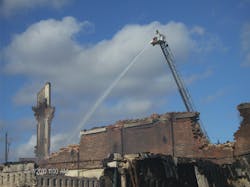On Sunday, Oct. 10, 2010, a four-alarm fire destroyed a vacant four-story mill on the Cornwall, Ontario, waterfront. The four-story building, part of Canada Cotton Mills, was constructed in the early 1900s of heavy timber and brick. The roof was covered with asphalt roofing. Each of the four floors contained 60,000 square feet of space. The building contained a sprinkler system that was in non-operating condition at the time of the fire.
The Cornwall Fire Department was dispatched to a report of smoke coming from the Cotton Mill at 150 Edward St. at 6:55 P.M. Pump 3 and Pump 5, both 5,000 liter-per-minute (1,320-gpm) pumpers; Aerial 2, a 30-meter (98-foot) aerial ladder with a 7,500-liter-per-minute (1,980-gpm) pump; and Rescue 7 responded with 10 firefighters under the command of Captain Dana Emerton-Proulx. While enroute, units were advised that flames were visible. Upon arrival, Pump 3 reported heavy smoke coming from the building with fire venting from two windows on the second floor on the south side of the building. Emerton-Proulx requested dispatch to contact Deputy Fire Chief Robert Hickley and inform him of the incident. He also requested an additional two officers and six firefighters to respond to the scene.
Initial Attack
Emerton-Proulx initiated a fast attack in an attempt to keep the fire in check while larger lines were being deployed. Firefighters placed a 7½-meter (24-foot) extension ladder to the second-floor windows on the south side and stretched a 60-meter (200-foot), 38-millimeter (1½-inch) attack line and placed it into operation. Emerton-Proulx continued his size-up of the building along the west and north sides.
At 7:11, fire was now venting out of the building at the northwest corner on the second and third floors. Emerton-Proulx requested two more officers and six firefighters to the scene. Returning to the south side where the fast attack was taking place, fire was now venting through four windows to the west of the initial attack and also windows on the third floor. Due to the rapid spread of the fire, it was decided to change to defensive operations.
Defensive Operations
After conferring with Lieutenants Steven O’Reilly and Andrew Van Veen, it was decided to concentrate efforts on protecting the exposures. Apparatus and firefighters were positioned to protect the building immediately to the east. This building, known as the Weave Shed, is of heavy timber and brick construction. The roof was covered with asphalt roofing. This building contained an operating sprinkler system. Source Wood Products, a wood-supply business, was located in the southwest corner of the building. Contained in this business was a large amount of wood, paints, stains and solvents.
Two elevated walkways connected the fire building and Weave Shed. A large tracked excavator was located on an adjacent property and the demolition company was contacted to bring it to the scene to remove the two walkways. At 7:43 P.M., the lower walkway was removed, but due to rapid fire spread, the excavator had to be removed from the area. Fire doors were located in both structures, on all floors, and were closed.
Lieutenant William Lalonde was assigned to ladder the Weave Shed and advance lines to the roof for protection. Two 7½-meter (24-foot) ladders were set up and two 38-millimeter (1½-inch) attack lines were advanced to the roof. There were no lines advanced into the Weave Shed as it was not on fire, but was protected from the exterior and checked on an ongoing basis. As well there was an operating sprinkler system in this building.
A 9,000-lt/min (2,376-gpm), 30-meter (98-foot) aerial platform was set up on the north side of the Weave Shed to protect this exposure. A 5,000-lt/min (1,320-gpm) pump was set up on the north side for water supply and relay purposes if needed. The department’s 32-foot (RV-based) Mobile Command Center was deployed for the accountability detail and as a rehab center for crews. Once it was determined that the fire would not spread to the Weave Shed, resources were reassigned to the original fire building.
Conclusion
The fire was declared under control at 8:10 P.M. on Oct. 12, 48 hours after the initial alarm. Forty-two firefighters operated three pumpers and two aerials at the scene. Firefighters used 985 feet of four-inch supply line, 328 feet of 2½-inch hose and 787 feet of 1½-inch attack line. Ten million gallons of water was used to extinguish the fire. One firefighter suffered minor injuries. Due to the fact that the building was vacant and scheduled for demolition, no investigation was conducted into fire cause and determination by the fire department; however, Cornwall Police proceeded with their investigation.
Manager of Emergency Services Myles Cassidy put forward a cautionary note to all fire departments: “Let’s be diligent of keeping a watchful eye on vacant structures” and the importance of a fully functioning sprinkler system operating.
On a personal note for our brother firefighters in the United States, the weekend that this incident occurred is the Canadian Thanksgiving Day holiday weekend. Incident Commander Captain Dana Emerton-Proulx, Manager of Emergency Services Myles Cassidy and Deputy Fire Chief Rob Hickley would like to express their heartfelt thank you to the initial-arriving crew of 1A Platoon and to all the members of the Cornwall Fire Department who left their families and friends during their Thanksgiving dinners to attend this major incident.






